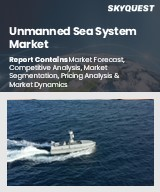
세계의 무인 해상 시스템 시장 규모는 2023년에 28억 달러로 평가되며, 2024년 31억 6,000만 달러에서 2032년에는 82억 8,000만 달러로 성장하며, 예측 기간(2025-2032년)의 CAGR은 12.8%로 성장할 전망입니다.
세계의 무인 해상 시스템 시장은 항해 및 자율적 의사결정을 강화하는 인공지능(AI)의 발전에 힘입어 강력한 성장세를 보이고 있습니다. 이러한 기술 발전은 어려운 수중 환경을 안전하게 탐사할 수 있게 해주며, 특히 유럽과 북미에서 선단의 업그레이드와 수중 매핑 개념의 확대로 인해 물량 증가를 촉진하고 있습니다. 또한 아시아태평양 국가들은 해저 정보와 해저 루트 매핑을 위해 전략적으로 자율 수중 로봇(AUV)을 획득하고 있습니다. 또한 배터리 기술, 수중 통신 시스템, 저소음 추진장치에 대한 막대한 투자가 시장의 안정성과 성장성을 강화하고 있습니다. 이 상황은 기술 혁신과 전략적 배치의 수렴으로 특징 지워지며, 세계 해상 무인 능력의 지속적인 발전의 무대가 되고 있습니다.
Global Unmanned Sea System Market size was valued at USD 2.8 billion in 2023 and is poised to grow from USD 3.16 billion in 2024 to USD 8.28 billion by 2032, growing at a CAGR of 12.8% during the forecast period (2025-2032).
The global market for unmanned sea systems is experiencing robust growth fueled by advancements in artificial intelligence (AI) that enhance navigation and autonomous decision-making. This technological progression enables safer exploration of challenging underwater environments, while fleet upgrades and expanding underwater mapping initiatives are driving volume increases, particularly in Europe and North America. Additionally, nations in the Asia-Pacific region are strategically acquiring Autonomous Underwater Vehicles (AUVs) for seabed intelligence and submarine route mapping. Furthermore, significant investments in battery technology, underwater communication systems, and low-noise propulsion are reinforcing the market's stability and growth potential. The landscape is marked by a convergence of innovation and strategic deployments, setting the stage for continued advancements in unmanned maritime capabilities globally.
Top-down and bottom-up approaches were used to estimate and validate the size of the Global Unmanned Sea System market and to estimate the size of various other dependent submarkets. The research methodology used to estimate the market size includes the following details: The key players in the market were identified through secondary research, and their market shares in the respective regions were determined through primary and secondary research. This entire procedure includes the study of the annual and financial reports of the top market players and extensive interviews for key insights from industry leaders such as CEOs, VPs, directors, and marketing executives. All percentage shares split, and breakdowns were determined using secondary sources and verified through Primary sources. All possible parameters that affect the markets covered in this research study have been accounted for, viewed in extensive detail, verified through primary research, and analyzed to get the final quantitative and qualitative data.
Global Unmanned Sea System Market Segments Analysis
Global Unmanned Sea System Market is segmented by Type, Capability, Application and region. Based on Type, the market is segmented into Unmanned Underwater Vehicles (UUV) and Unmanned Surface Vehicles (USV). Based on Capability, the market is segmented into Remotely Operated Vehicles and Autonomous Vehicles. Based on Application, the market is segmented into Military, Commercial and Other Applications. Based on region, the market is segmented into North America, Europe, Asia Pacific, Latin America and Middle East & Africa.
Driver of the Global Unmanned Sea System Market
The Global Unmanned Sea System market is being significantly driven by an increase in defense spending among various countries seeking to enhance their unmanned maritime capabilities. This surge is largely attributed to the demand for force multiplication and cost-effective Intelligence Surveillance and Reconnaissance (ISR) solutions, which has led to a heightened procurement of Autonomous Underwater Vehicles (AUVs) and Unmanned Surface Vehicles (USVs). Collaborative initiatives among nations, particularly those in Asia-Pacific and Europe, are fostering advancements in AI-based navigation and long-endurance mission modules. As a result, autonomous sea platforms are becoming essential strategic assets in defense, aligning with evolving geopolitical demands for enhanced operational readiness and surveillance capabilities.
Restraints in the Global Unmanned Sea System Market
One of the key market restraints for the global unmanned sea system market is the regulatory challenges associated with maritime operations. Compliance with international maritime laws, safety regulations, and environmental protections poses significant hurdles for developers and operators of unmanned sea systems. The lack of standardized regulations across different jurisdictions can lead to uncertainties and increased operational costs. Furthermore, the need for permits and adherence to stringent guidelines can slow down innovation and deployment of these technologies. As nations grapple with emerging maritime security concerns and environmental impacts, navigating this complex regulatory landscape remains a crucial challenge for market participants.
Market Trends of the Global Unmanned Sea System Market
The Global Unmanned Sea System market is witnessing a transformative trend as artificial intelligence (AI) increasingly drives autonomy in naval operations. By 2024, AI-operated unmanned maritime systems are redefining mission protocols through autonomous route-following, real-time threat detection, and onboard decision-making, moving beyond traditional hard-coded algorithms. Industry leaders like L3Harris and Elbit Systems are integrating adaptive autonomy in their latest vessel designs, enabling enhanced underwater and surface operations without human intervention. This pivotal shift highlights the growing demand for advanced, intelligent unmanned systems, positioning AI as a critical catalyst in the evolution of naval strategy and operational capabilities within the maritime defense sector.